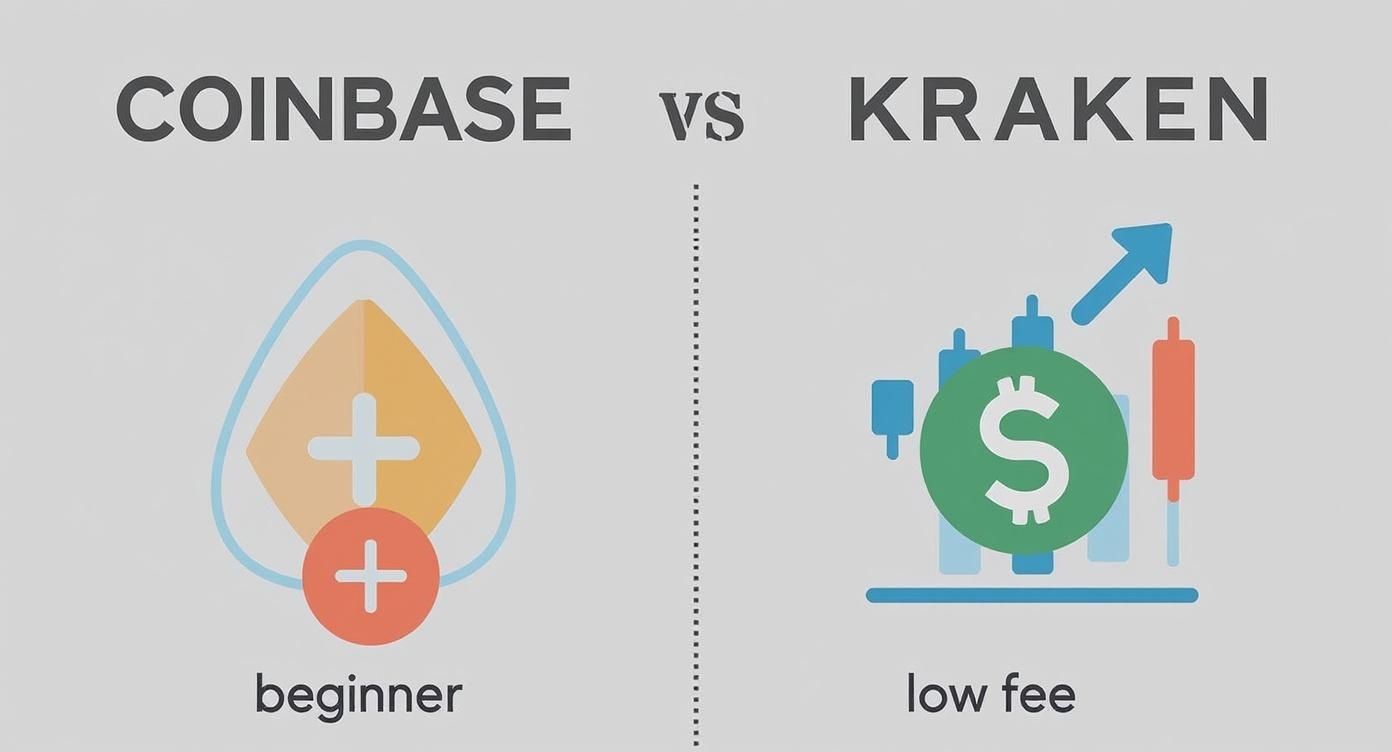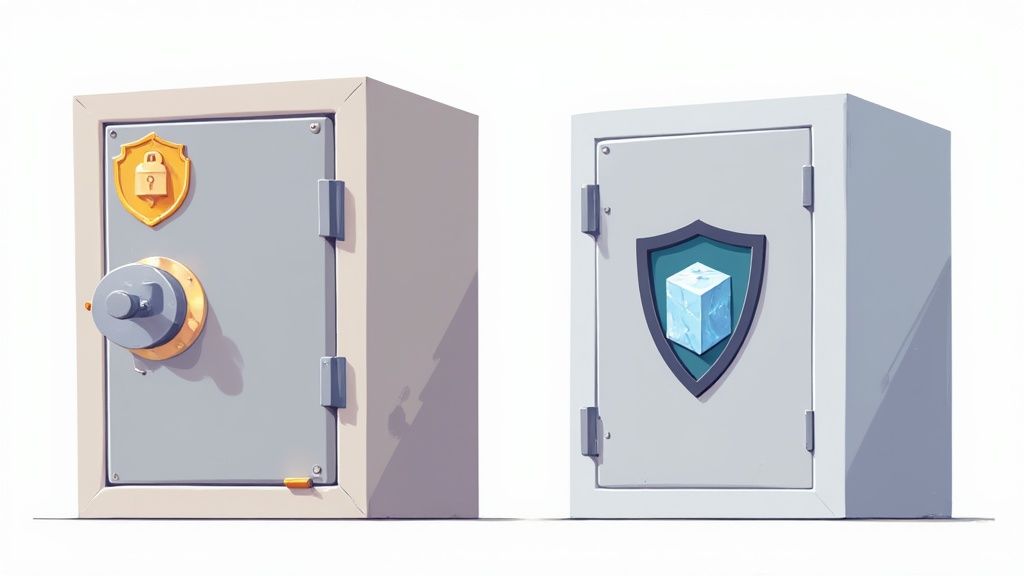What Is Dexscreener? A Guide to DeFi Trading
Wondering what is Dexscreener? This guide breaks down how to use its powerful charts, data, and tools to find better DeFi trading opportunities.

November 15, 2025
Wallet Finder

November 16, 2025

Choosing between Kraken and Coinbase boils down to your experience level and crypto goals. The short answer? Coinbase is better for beginners due to its simple interface. On the flip side, Kraken is superior for active traders who need lower fees and advanced tools.
Your choice ultimately depends on whether you value ease of use over cost-effective, powerful trading.
When figuring out where to buy, sell, and trade crypto, the Kraken vs. Coinbase debate often comes down to a few critical differences. Coinbase has cemented its reputation as the go-to platform for newcomers in the United States, mostly due to its intuitive design and powerful brand recognition.
In fact, Coinbase held a 6.9% market share among the top 10 global exchanges for U.S. consumers as of April. You can dive deeper into crypto exchange market shares to see how these platforms stack up globally.
Kraken, however, plays to a different crowd. It’s all about providing a more robust trading experience with much lower fees, especially on its Kraken Pro platform. This makes it a favorite for frequent traders, institutions, and anyone focused on minimizing costs while getting access to a wider arsenal of order types and assets.

The takeaway is pretty clear: let your crypto journey and how often you plan to trade be your guide.
While both exchanges are top-tier, their core philosophies on user experience, cost, and features create distinct advantages for different types of investors. Getting a handle on these high-level differences is the first step in picking the right home for your crypto.
Key Insight: The fundamental tradeoff is simplicity versus cost. Coinbase makes buying crypto incredibly easy but charges a premium for it. Kraken offers a more professional environment that rewards you with lower fees for taking the time to learn its more complex interface.
To get started, here’s a quick table breaking down the most important differences. It will help you see which exchange aligns with your priorities before we get into the nitty-gritty of each category.
This at-a-glance view sets the stage, but the devil is in the details. Let's break down how these two giants truly compare across the features that matter most to traders and investors.

Let's talk about what really matters: how much you pay to trade. Fees are the silent killers of profit in crypto, and this is where the Kraken or Coinbase debate gets interesting. The two platforms couldn't be more different in their approach. Coinbase is all about making your first crypto purchase easy, but that convenience comes at a premium.
Kraken, on the other hand, is built from the ground up for active, cost-conscious traders. It offers some of the lowest fees you'll find anywhere, especially if you trade with any regularity. Getting a handle on these costs is the first step, and if you're serious about your returns, understanding how to calculate crypto profit will show you just how much fees can impact your bottom line.
Coinbase has a split personality when it comes to fees, and it often trips up new users. The main Coinbase platform—the one you see advertised everywhere—is designed for simplicity. It charges a spread on top of a "Coinbase Fee," which can be painfully high, particularly for smaller buys. It's easily one of the most expensive ways to get into the market.
For a much better deal, you have to find your way to Coinbase Advanced. This is their proper trading interface, which uses a standard maker-taker model.
While Coinbase Advanced is a huge improvement, its starting fees are still higher than what Kraken Pro offers right out of the gate.
For traders who watch every penny, Kraken Pro is the clear destination. It operates on a pure maker-taker model that rewards traders with lower fees as their trading volume increases. But the key difference is that Kraken Pro's starting fees are significantly lower than Coinbase Advanced's.
A brand-new trader on Kraken Pro gets access to a fee schedule that’s already among the most competitive in the industry. For anyone planning to trade more than once or twice, the savings add up fast.
Key Takeaway: If you're going to trade even semi-regularly, Kraken Pro offers an immediate and significant cost advantage over both standard Coinbase and Coinbase Advanced. The difference is big enough to be a deal-breaker for many.
Let's make this tangible. Imagine you're making a $1,000 spot trade for Bitcoin. The platform you choose will have a dramatic effect on how much you actually pay.
The table doesn't lie. The simple Coinbase interface is, by a massive margin, the most expensive option. Coinbase Advanced is a respectable alternative, but Kraken Pro is the undisputed winner on cost for the exact same trade. For anyone serious about maximizing returns, keeping trading costs low isn't just a nice-to-have—it's a fundamental part of a winning strategy.

In crypto, security isn’t just a feature—it’s the entire foundation of trust. When you’re choosing between Kraken or Coinbase, understanding how each platform guards your funds is absolutely critical. Both are pioneers with solid track records, but they approach protection from slightly different angles, which might make one a better fit for your personal risk tolerance.
As a publicly traded US company, Coinbase operates under a microscope of regulatory oversight, leading to a security posture built on compliance and institutional-grade controls. Kraken, while also fully compliant, built its reputation from day one on a hardcore, security-first mindset, often creating the best practices that later became industry standards.
Ultimately, keeping your assets safe is the number one priority. To get a better handle on the core concepts, our guide on a crypto exchange vs a wallet is a great primer on the pros and cons of self-custody versus leaving your funds with a third party.
The undisputed best practice for storing crypto is in cold storage, meaning it's kept completely offline and away from internet-based threats. This is one area where both Kraken and Coinbase absolutely shine, holding the overwhelming majority of customer funds in geographically distributed, air-gapped vaults.
Here is a quick checklist of what that means for you:
Coinbase publicly states that 98% of all customer crypto is held in cold storage. Kraken also runs on a full-reserve basis with legendary physical security, including armed guards and constant monitoring.
This is where you start to see some clear daylight between the two. Each exchange offers a different type of financial protection that will appeal to different kinds of users.
Key Differentiator: Coinbase gives users the comfort of traditional finance with FDIC insurance for cash balances. Kraken builds trust through radical transparency, offering cryptographic proof that your crypto is actually where it's supposed to be.
While the exchange’s security is paramount, you are the first line of defense for your own account. Both platforms give you a powerful set of tools to lock things down, and your preference here might be what seals the deal.
Here’s how they stack up on the most important user-controlled security features:
Kraken has a slight edge for power users with its Global Settings Lock. If you enable this, no critical changes (like password or 2FA resets) can be made to your account for 24 hours, giving you a vital window to act if your account is ever compromised. That said, both strongly push for hardware security keys, which remains the gold standard for protecting your account.
The right tools and a deep pool of assets are what separate a casual purchase from a sophisticated trading strategy. When you line up Kraken and Coinbase, their product offerings show two very different philosophies: one built for the professional trader, the other for mass-market accessibility. Your choice here dictates not just what you can trade, but how you can trade it.
Kraken has built its reputation as the go-to exchange for serious traders and institutions. Why? A powerful trading engine, deep liquidity, and a huge variety of advanced order types. With support for over 200 cryptocurrencies and tons of trading pairs, it’s a playground for traders who want options. Add in high-yield staking, professional charting, and a rock-solid API, and you have a platform that meets the needs of the most demanding users. On Kraken Pro, fees are incredibly competitive, starting at just 0.16% for makers and 0.26% for takers.
For a broader look at how exchanges are competing for market share, Ainvest.com published a great analysis on the current landscape.
Sure, both platforms will sell you Bitcoin (BTC) and Ethereum (ETH). That's table stakes. The real difference is in the long tail of altcoins and emerging tokens. Kraken has always been faster to list a broader selection of assets for its global users, making it the better choice for traders hunting for the next big thing or diversifying into less-traveled markets.
Coinbase plays it much safer, especially for its U.S. customers. It tends to list assets only after they’ve passed a certain threshold of market maturity and regulatory scrutiny. For beginners, this is a plus—it acts as a natural filter against some of the market's more speculative and volatile projects. For active traders, it can feel restrictive.
This is where the two platforms really diverge. While both offer solid spot trading, their advanced offerings tell a completely different story. It’s a critical point to consider if you plan on doing more than just buying and holding.
Key Insight: If you're looking for leverage, whether through margin or futures, Kraken is in a different league. Its product suite is far more developed and accessible (geography permitting). Coinbase has doubled down on being the safest, simplest place to trade spot.
The ability to execute a precise strategy often boils down to the specific order types an exchange offers. A simple market or limit order is fine for basic buys, but serious traders need more control. The table below gives you a side-by-side look at the trading products and services available on each platform.
While Coinbase Advanced is a perfectly capable platform, this breakdown shows that Kraken Pro was built from the ground up with the professional trader in mind. The inclusion of orders like trailing stops and nuanced take-profit triggers allows for automated risk management that you just can't do on Coinbase. For traders connecting to a tool like Wallet Finder.ai for alerts and copy trading, Kraken's superior order types and powerful API provide a huge practical advantage.

An exchange's design and feel have a huge impact on your trading confidence and speed. The choice between Kraken or Coinbase often boils down to this exact point, as they’re built for completely different people. Coinbase famously nailed simplicity, creating a frictionless path for total beginners to get into crypto.
Kraken, on the other hand, presents a much more data-heavy environment. Its pro-level interface, Kraken Pro, is built for active traders who need instant access to advanced charting tools, live order books, and deep market data. This split in design philosophy means one platform will feel like home while the other might seem like a maze, depending on your experience.
Coinbase has the beginner onboarding experience down to a science. The process is incredibly simple, walking you through linking a bank account and making your first buy in just a few minutes. Its clean, minimal layout strips away the scary jargon and complex charts that usually overwhelm newcomers.
Kraken’s sign-up is also fast, but it immediately throws more options and information at you. While basic verification is quick, the platform nudges you to explore its more powerful features right away. This can be a small hurdle for true beginners but is exactly what seasoned traders want—no hand-holding, just straight to the action.
User Experience Takeaway: Coinbase holds your hand, making it almost impossible to get lost. Kraken gives you the keys to a high-performance machine from the get-go, assuming you already know how to drive.
You can really see the difference when comparing their main trading platforms: Coinbase Advanced and Kraken Pro.
This clear design separation shows in their market share. According to Coingecko's April data, Coinbase had a 6.9% share of global spot trading volume, down just a bit from 7.0% at the start of the year. Meanwhile, Kraken didn't make the top 10, meaning it fell below the 5.4% cutoff. This suggests it serves a more niche, trader-focused audience. You can dig into more stats on the centralized exchange market share to see how things are trending.
Both exchanges offer excellent mobile apps that stick to the same script as their desktop versions. The Coinbase app is perfect for a quick balance check or making simple trades on the move. The Kraken Pro app, however, is a full-blown trading terminal in your pocket, offering a surprisingly powerful experience for mobile-first traders.
Trying to keep track of assets across multiple exchanges gets messy fast. This is why using one of the best crypto portfolio tracker tools is a smart move to get a single, unified view of everything.
When you run into trouble, both platforms have extensive help centers. But Kraken gets a lot of praise for its 24/7 live chat, which gives you a direct line for urgent problems. This can be a game-changer compared to Coinbase's more structured support system, especially when you need an answer right now.
Choosing between Kraken or Coinbase isn’t about finding a single "best" exchange. It's about picking the right tool for the job. After digging into their fees, security, and features, the right choice becomes much clearer when you consider who you are as an investor.
Your experience level, how often you plan to trade, and your overall financial strategy will naturally point you to one or the other.
If you're just starting out, your main goal should be a simple, secure, and understandable first step into crypto. This is where Coinbase shines. It's built from the ground up to make buying your first Bitcoin or Ethereum feel as familiar as any other online purchase.
For anyone who plans on trading regularly, minimizing costs, or using more advanced order types, the choice is just as clear. You simply can't ignore the impact of fees on your bottom line, and this is where Kraken has a massive advantage.
Kraken Pro’s low, volume-based fee schedule ensures you keep more of your profits with every trade. That, combined with its wider selection of assets and more sophisticated trading tools, gives you the power to execute strategies with precision.
For institutions, algorithmic traders, and developers building on crypto rails, the decision comes down to API performance, liquidity depth, and custody solutions. Both platforms offer robust institutional-grade services, but they cater to slightly different crowds.
Key Insight: Kraken's security-first culture, famously demonstrated by its pioneering of Proof of Reserves audits, and its highly-regarded API make it a go-to for professional trading shops and crypto-native funds. Coinbase Custody, on the other hand, with its ironclad compliance framework, is often the first stop for traditional financial players making their entry into digital assets.
Ultimately, you don't have to choose just one. A popular and highly effective strategy is to use both platforms for what they do best. Many savvy traders use Coinbase for its world-class fiat on-ramps to easily get cash into the ecosystem, then transfer those assets to Kraken Pro to trade with lower fees and access a wider market.
This hybrid approach lets you leverage the unique strengths of each exchange, creating a workflow that's far more efficient and powerful than relying on a single platform.
When you're weighing Kraken against Coinbase, a few key questions usually bubble up to the surface. Let's tackle them head-on so you can make a decision that fits your goals.
For anyone just starting out, especially in the US, Coinbase is the better choice. They've poured a ton of resources into making their user interface incredibly simple. Linking your bank account and making that first crypto purchase is about as easy as it gets.
Yes, the fees on their main platform are higher, but what you're paying for is a frictionless, secure entry point into the crypto world. Coinbase does an excellent job of stripping away the complexity that often intimidates newcomers.
This one isn't even a close fight. Kraken, specifically through its Kraken Pro platform, has dramatically lower fees for active traders than Coinbase Advanced.
Kraken's maker-taker fee structure is built for volume. It starts low and gets even cheaper the more you trade, making it the clear winner for anyone who's trading frequently or moving serious size. If cost is your primary driver, Kraken Pro is the answer.
Absolutely. In fact, using both is a smart strategy that many experienced crypto traders and investors rely on to get the best of both worlds.
A common and highly effective workflow is to use Coinbase for its easy, fast fiat on-ramping. From there, you can transfer your assets over to Kraken to take advantage of its superior fee structure, wider range of assets, and more advanced trading tools.
This hybrid approach allows you to onboard your cash through the simplest path (Coinbase) and then trade it on the most cost-effective and powerful platform (Kraken). There's no reason to limit yourself to just one.
Ready to turn on-chain data into actionable trading signals? Wallet Finder.ai helps you discover the market's top-performing wallets and mirror their strategies in real time. Start tracking smart money movements and get alerts before the crowd.
"I've tried the beta version of Walletfinder.ai extensively and I was blown away by how you can filter through the data, and the massive profitable wallets available in the filter presets, unbelievably valuable for any trader or copy trader. This is unfair advantage."
.avif)
Pablo Massa
Experienced DeFi Trader